Complete Solutions to Section-E MCQs of chapter THERMODYANMICS of Class 11 book with complete answers and questions
| Class 11 | PHYSICS |
| Chapter | THERMODYANMICS |
| KUMAR PRAKASHAN | Section-E MCQs |
| Number Of Questions | 42 |
| Academic Year | 2023-24 |
Heat absorbed by the gas undergo a cylic process along closed path in one complete cycle as shown in figure will be _____ J.

View SolutionA scientist says that the efficiency of heat engine which work at source temperature `127^@ C` and sink temperature `27^@ C` is 26 % then ______
View SolutionAn ideal gas heat engine operates in a carnot cycle between `227^@` C and `127^@` C. It absorbs 6 kcal at the higher temperature. The amount of heat (in kcal) converted into work is equal to _____
View SolutionOne mole of an ideal gas at an initial temperature of TK does 6R Joule of work adiabatically. If the ratio of specific heat of this gas at constant pressure and at constant volume is `5/3`, the final temperature of gas will be ____
View SolutionA carnot.engine whose sink is at 300 K has an efficiency of 40 %. By how much should the temperature of source be increased so as to increase its efficiency by 50% of original efficiency ?
View SolutionAn electric kettle takes 4 A current at 220 V. How much time will it take to boil 1 kg of water from temperature `20^@`C ? The temperature of boiling water is `100^@` C.
View SolutionIf Q, E and W denote respectively the heat added, change in internal energy and the work done by a closed cycle process, then
View SolutionIn thermodynamic processes which of following statement is not true ?
View SolutionIf `DeltaU` and `DeltaW` represent the increase in internal energy and work done by the system respectively in a thermodynamical process which of the following is true?
View SolutionWhen 1 kg of ice at `0^@` C melts to water at `0^@` C, the resulting change in its entropy, taking latent heat of ice to be `80 "cal/".^@C` is ____
View SolutionWhich quantity remains constant in an adiabatic process ?
View SolutionFor increase in internal energy of a system is equal to the work done on the system. Which process does the system undergo ?
View SolutionThe relation between pressure and temperature of a monoatomic gas in an adiabatic process is `P prop T^(-C)`, where C = ____
View Solutionn moles of a monoatomic gas is carried round the reversible rectangular cycle ABCDA as shown in the diagram. The temperature at A is `T_0`. The thermodynamics efficiency of the cycle ____
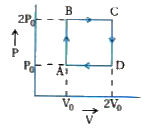
View SolutionPressure versus temperature graph of an ideal gas is as shown in figure. Density of the gas at point A is `rho_0` . Density at point B will be ____
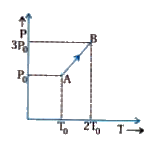
View SolutionGraph of specific heat at constant volume for a monoatomic gas is ____
View SolutionFor an adiabatic process ____
View SolutionFor cyclic process which of the following quantity is zero ?
View Solution`1 "cm"^3` of water at 1 atm pressure is converted into steam, volume of steam becomes `1671 "cm"^3` hence increase in internal energy will be ____
View SolutionTwo rigid boxes containing different ideal gases are placed on a table. Box A contains one mole of nitrogen at temperature `T_(0)`, while box B contains one mole of helium at temperature `(7//3)T_(0)`. The boxes are then put into thermal contact with each other , and heat flows between them until the gases reach a common final temperature (Ignore the heat capacity of boxes). Then , the final temperature of gases, `T_(f)` , in terms of `T_(0)` is -
View SolutionA carnot engine having an efficiency of `eta=1/10` as heat engine is used as a refrigerator. If the work done on the system is 10 J, the amount of energy absorbed from the reservoir at lower temperature is _____
View SolutionHelium gas goes through a cycle ABCDA as shown in figure. Efficiency of this cycle is nearly _______ (Imagine He is an ideal gas)
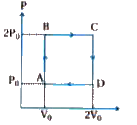
View SolutionOne mole of diatomic ideal gas undergoes a cyclic process ABC as shown in figure. The process BC is adiatomic. The temperature of A, B and C are 400 K, 800 K and 600 K respectively. Choose the correct statement ____
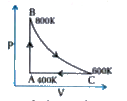
View SolutionFigure below shows two paths that may be taken by a gas to go from a state A to a state C. In process AB, 400 J of heat is added to the system and in process BC 100 J of heat is added to the system. The heat absorbed by the system in the process AC will be .....
View SolutionOne mole of an ideal diatomic gas undergoes a transition from A to B along a path AB as shown in the figure, The change in internal energy of the gas during the transition is:
View SolutionThe coefficient of performance of a refrigerator is 5. If the temperature inside freezer is `- 20^@ C`, the temperature of the surroundings to which it rejects heat is _____
View SolutionAn ideal gas is compressed to half its initial volume by means of several processes. Which of the process results in the maximum work done on the gas ?
View SolutionThe value of coefficient of volume expansion of glycerin is `5 xx 10^(-4) K^(-1)`. The fractional change in the density of glycerin for a rise of `40^@` C in its temperature is _____
View Solution4.0 g of a gas occupies 22.4 litres at NTP. The specific heat capacity of the gas at constant volume is `5.0 "JK"^(-1) "mol"^(-1)`. If the speed of sound in this gas at NTP is `952 "ms"^(-1)` , then the heat capacity at constant pressure is _____ `(R=8.3 "JK"^(1) "mol"^(-1))`
View SolutionA gas is compressed isothermally to half its initial volume. The same gas is compressed seperately through an adiabatic process until its volume is again reduced to half. Then _____
View SolutionA refrigerator works between `4^@C` and `30^@C`. It is required to remove 600 calories of heat every second in order to keep the temperature of the refrigerated space constant. The power required is _____ (1 cal = 4.2 Joules)
View SolutionTwo identical bodies are made of a material for which the heat capacity increases with temperature. One of these is at `100^@` C, while the other one is at `0^@` C. If the two bodies are brought into contact, then assuming no heat loss the final common temperature is _____
View SolutionOne mole of an ideal monoatomic gas undergoes a process described by the equation `PV^3` = constant. The heat capacity of the gas during this process is ……..
View SolutionThe temperature inside a refrigerator is `t_2^@C` and the room temperature is `t_1^@C`. The amount of heat delivered to the room for each joule of electrical energy consume ideally will be _____
View SolutionThe volume of one mole of an ideal gas with adiabatic exponent `gamma` is varied according to `V=b/T`, where b is a constant. Find the amount of Heat is absorbed by the gas in this process temperature raised by `DeltaT`
View SolutionOne mole of gas obey the equation of state P(V - b) = RT and changes its coordinate from `(P_1, V_1)` to `(P_2, V_2)` which is established on P-V diagram by line. The work done in this changes will be _____
View SolutionThermodynamic process are indicated in the following diagram. Then match the following process in a correct manner.

View SolutionA sample of 0.1 g of water at `100^@ C` and normal pressure `(1.013 xx 10^5 Nm^(-2))` requires 54 cal of heat energy to convert to steam at `100^@ C`. If the volume of the steam produced is 167.1 cc, the change in internal energy of the sample is ____
View SolutionTwo wires are made of the same material and have the same volume. The first wire has cross sectional area A and the second wire has cross sectional area 3A. If the length of the first wire is increased by `Deltal` on applying a force F, how much force needed to stretch the second wire by the same amount ?
View SolutionThe volume (V) of a monoatomic gas varies with its temperature (T), as shown in the graph. The ratio of work done by the gas, to the heat absorbed by it, when it undergoes a change from state A to state B, is ____
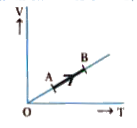
View SolutionThe efficiency of an ideal heat engine working between the freezing point and boiling point of water is ____
View SolutionTwo moles of an ideal monoatomic gas occupies a volume V at `27^@ C`. The gas expands adiabatically to a volume 2 V. Calculate (a) the final temperature of the gas and (b) change on its internal energy.
View Solution
Section-E MCQs questions and complete solutions for chapter THERMODYANMICS of KUMAR PRAKASHAN KENDRA PHYSICS (GUJRATI ENGLISH) of Class 11
All Exercises from KUMAR PRAKASHAN Class 11 PHYSICS THERMODYANMICS
- Question Paper
- Section-A (Questions-Answer )
- Section-A (Try Your self )
- Section-B Numericals (Numerical From .Darpan. Based on Textbook )
- Section-B Numericals (Numerical From Textual Exercise)
- Section-C (Objective Questions (Assertion & Reason )
- Section-C (Objective Questions (Fill in the blanks ) )
- Section-C (Objective Questions (Match))
- Section-C (Objective Questions (True & False ))
- Section-C (Objective Questions (VSQs))
- Section-D Ncert Exemplar Solution (Long Answer )
- Section-D Ncert Exemplar Solution (MCQs More than one option )
- Section-D Ncert Exemplar Solution (MCQs)
- Section-D Ncert Exemplar Solution (Short Answer )
- Section-D Ncert Exemplar Solution (Very Short Answer )
- Section-E MCQs
- Section-F Questions from Module